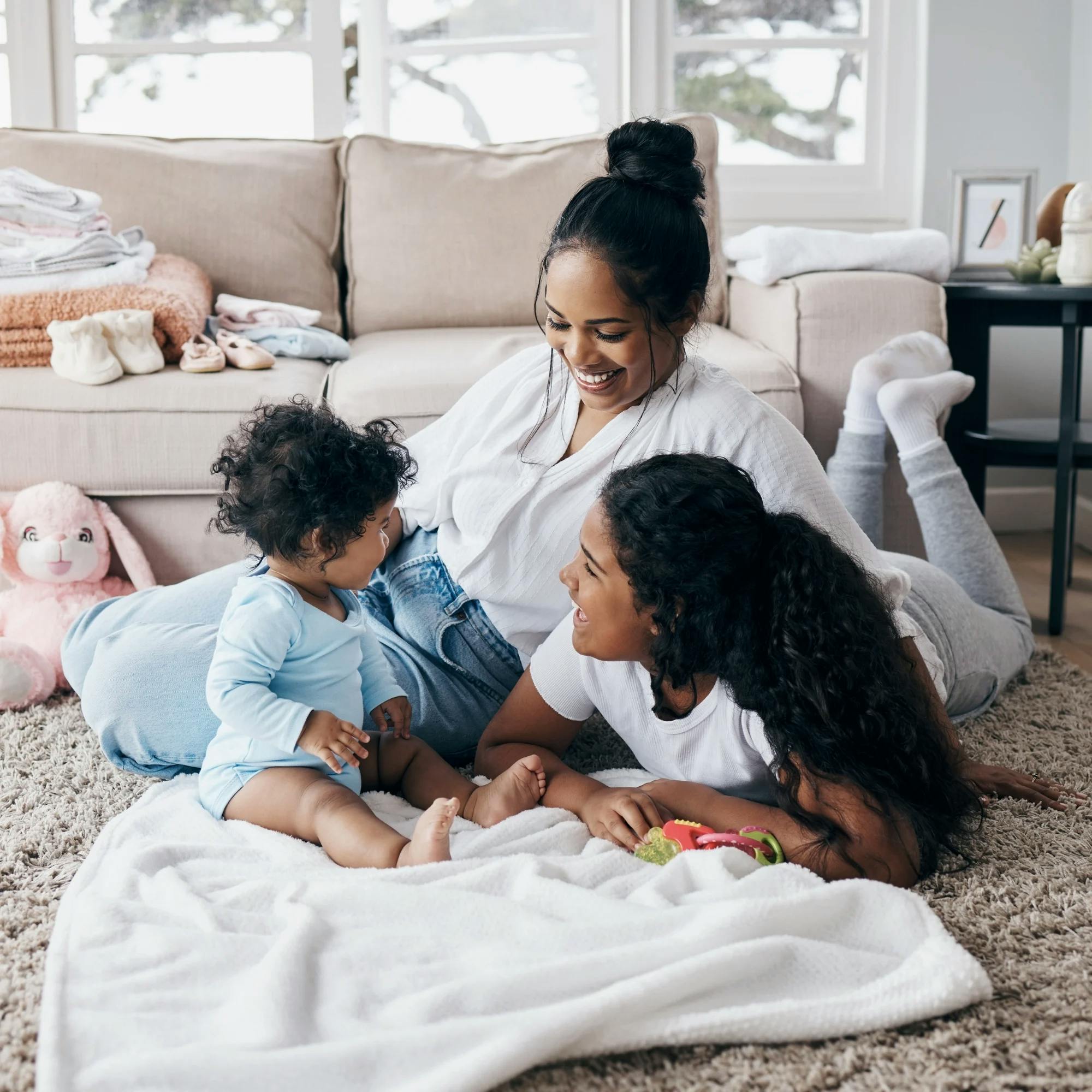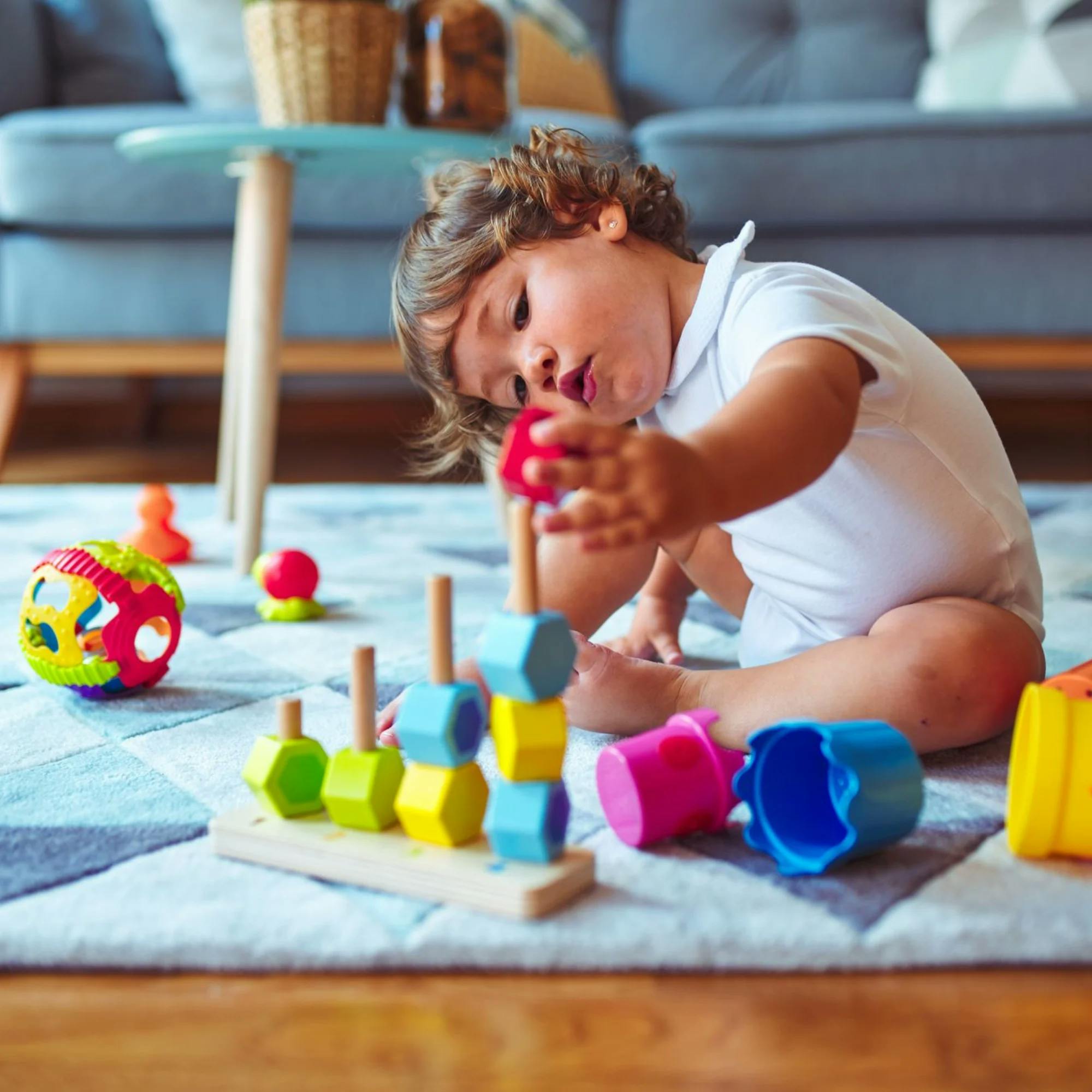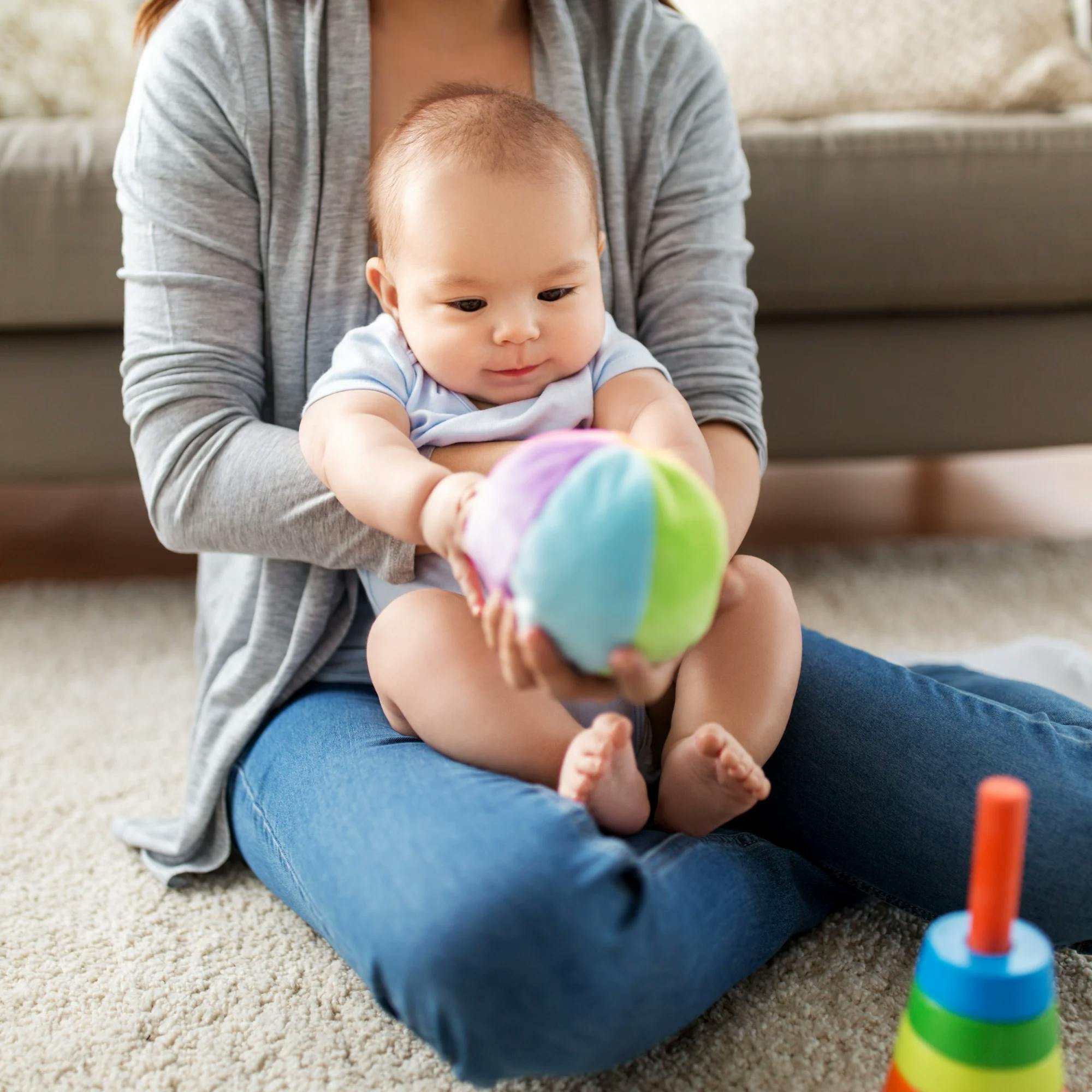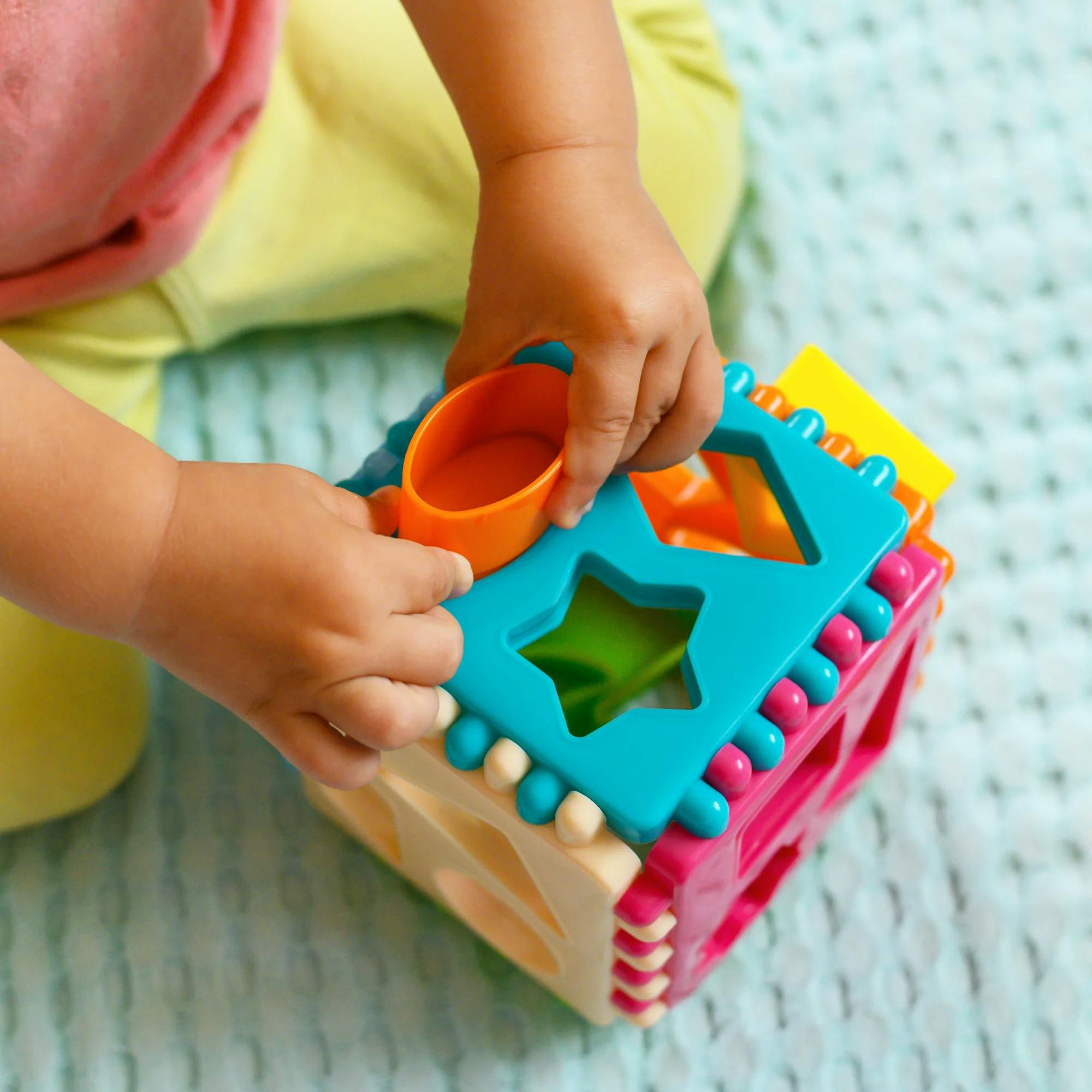If you’ve got a new infant at home, you may be wondering whether you should “play” with your baby–or how to even do that, since they mainly eat and sleep all day. How can you play with a 2-month-old? At what age should you start playing with your baby?
Read on for some fun activities to do with your baby from birth through 6 months. You’ll also find out why these interactions matter so much to your child’s growth and development.


Ways to play with your newborn baby (up to age 3 months)
The newborn stage is typically considered to be from birth to 3 months old. Your baby will become more alert as they get older. But in the early weeks, they tend not to be very interactive, and they’re often sleepy during the day.
You may be wondering whether a newborn needs any toys. When it comes to entertaining your newborn, the good news is that pretty much everything is a new experience to them! And on top of that, they don’t need much to stimulate them. So games that foster interaction, like tickling or trying out new toys, aren't exactly what they need at this stage.
You can “play” with your newborn in simple ways. Here are some ideas:
1 Hold and cuddle your newborn
During the first month of your baby’s life, hold them and cuddle them often. Focus on building your bond together. This will strengthen your communication with your baby, as well. For example, you’ll learn what their cries mean–or at least be able to make a better guess. (No matter how close your bond is, it’s not always easy to tell what babies need!)
As you take care of your baby for a longer period of time, they will learn that when they cry, you respond. These early days help your baby learn the cause-and-effect basics of communication.


2 Narrate what you’re doing out loud
If you’re looking for a specific activity, try narrating what you do as you go about your day. While your newborn's first words are probably around a year away, their first sounds, like cooing and babbling, are right around the corner. Hearing you speak will help them pick up the sounds and intonation of our language.
This works on walks, while you’re doing chores, while you’re at the store–any daily routine. Simply talk to your baby about what you’re doing. It may feel silly, but try narrating your tasks like this: “I’m getting your bag ready. Look! I got your diaper. I got your bottle. Now I zip up the bag! Let’s get in your car seat.”
It may feel silly, but simply talk to your baby about what you’re doing.
Keep in mind that young babies don’t have keen eyesight. So anything that’s not within 8 to 12 inches from them will appear fuzzy. If you want to show them items as you speak, hold them up close. However, right now, the goal is to let your baby listen to your conversational speech, rather than learn the names of objects. You can focus on that as your baby grows older.
If you wear your baby in a baby carrier, this is a great time to narrate and talk to them. Try singing to them, as well! They’ll be snuggled up close to you and enjoy listening to your voice.


3 Make time for tummy time
Tummy time is important for babies, even in the newborn days. In fact, most babies can start doing tummy time a few days after they’re born. Being on their stomachs helps babies strengthen the muscles in their back and neck. This will eventually help them with rolling, sitting, crawling, and walking! They’ll learn how to lift their head and chest, and they’ll grow their hand-eye coordination by reaching for toys as they get older.
To do tummy time, place your baby on the ground on their stomach. Do this someplace soft, like on the carpet or on blankets, and not near any surfaces where they could fall.
It’s a good idea to not do tummy time right after your baby eats. You probably don’t have to be reminded that an uncomfortable baby who’s spitting up is no fun for anyone!
You can use toys to help your baby stay motivated to look around and lift their head up.
During tummy time, stay right by your baby the whole time. See if they can lift their head and chest. It will take your baby some time to practice before their strength grows. You can use toys, like these high-contrast cards, baby mirror, or even a play mat, to help your baby stay motivated to look around and lift their head up.
Give your baby time to practice, and slowly increase the length of their tummy time. The National Institute of Child Health and Human Development recommends doing two or three short (3- to 5-minute) tummy time sessions each day. As your baby gets older, you can have longer sessions throughout the day. By about 2 months old, babies should be getting 15 to 30 minutes of total tummy time daily.


Ways to play with babies ages 3 to 6 months
As your baby enters the 3-to-6-month stage, you’ll see them becoming a lot more interactive. By this age, they’re typically smiling and starting to giggle. These are fun and memorable milestones!
1 Show your baby how toys work
When do babies start playing with toys? At age 4 or 5 months, your baby will start becoming more interested in toys. At first they may just bang them together or put them in their mouth. That’s OK! They’ll start playing more as they get closer to 6 months old.
For now, simply show them what to do with the toy. Push buttons, make sounds for toy animals or cars, and show them how fun playing is! Your baby will start engaging more with toys over time.


2 Use cause-and-effect toys
Cause-and-effect toys are great for helping your baby start to understand play routines and the basics of communication. As we mentioned earlier, communication is essentially a cause-and-effect relationship: one person speaks, the other receives the message and responds. Of course, your 5-month-old baby isn’t yet talking, or even using gestures to communicate. But they can certainly start learning cause and effect through play!
Here are three examples of cause-and-effect comprehension developed through play:
Blocks can stack, but if you push them over, they will fall.
If you push a toy train, it will drive on the track where you want it to go.
Many toys have buttons, levers, or other items to push. When you do, something fun happens!


3 Interact with your baby through simple games
Age 3 to 6 months is a great stage to play simple, interactive games, such as making silly or happy faces at your baby. Eventually they will begin copying you! You can also try peek-a-boo to see what your child does. At first, they’ll likely smile or giggle. But once they get older, they’ll start playing the game with you.
4 Read daily with your baby
If you haven’t started a reading routine with your baby, now is the time to do it! You can start teaching your 3- to 6-month-old the names of things in pictures. Point to the page to show what you’re talking about, and discuss the story out loud so they get good exposure to how we structure our language.


More tips for playing with your baby
When should you play with your baby? Pay attention to the times of day when your baby is happiest and most awake. These are the times to try new activities.
Your infant may not have a set schedule yet. It takes awhile for babies to get their days and nights figured out. But even if your baby isn’t on a strict schedule, they will likely still follow a pattern of eating, staying awake for awhile, then taking a nap. This cycle will repeat itself many times throughout the day! The key to successful play interactions with your baby is to do these activities when your baby is most alert and happy. One note: Try not to play with them too close to naptime. They’ll likely be getting fussy at this point.
As your baby gets older, you’ll be able to tell what they enjoy most. If they love reading, make sure to read stories together daily. If they love going on walks, make walking a part of your evening routine. You know your baby best, and you’ll find ways to keep them learning and engaged throughout their day. Not to mention, you’ll be making special memories together. Celebrate every new thing your child does, and celebrate your accomplishments as a parent or caregiver, as well–even the small ones. You deserve it!

 Abby Barnes, M.S., CCC-SLP
Abby Barnes, M.S., CCC-SLP









